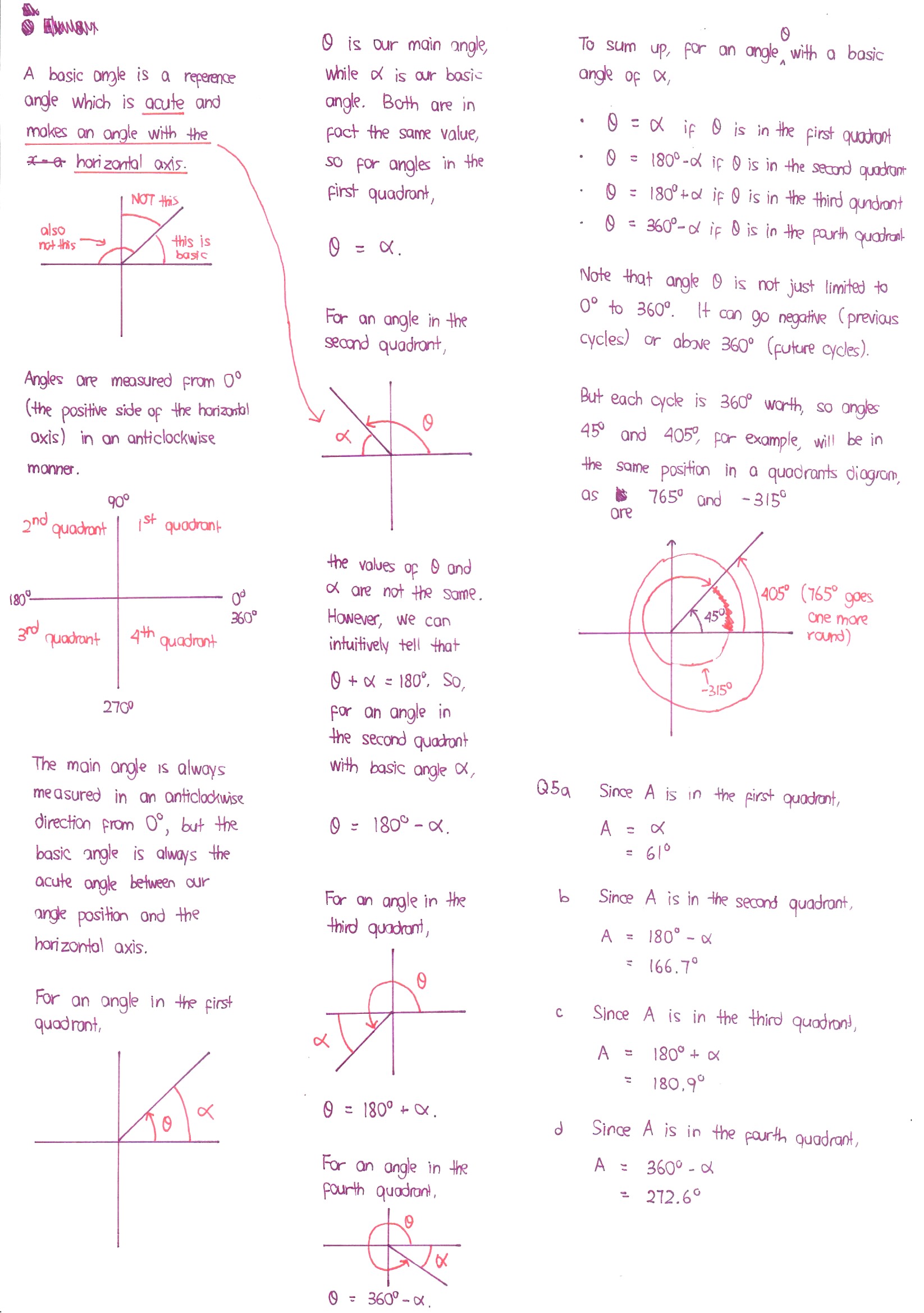Eric Nicholas K's answer to LockB's Secondary 3 A Maths Singapore question.
done
{{ upvoteCount }} Upvotes
clear
{{ downvoteCount * -1 }} Downvotes
Q5, and a little bit on the quadrants and basic angles
Date Posted:
3 years ago
for negative angles does it work the same way as positive angles but we calculate it from the 4th quadrant?
like 4th quadrant will be 1st quadrant for negative angle, 3rd quadrant will be 2nd and so on
like 4th quadrant will be 1st quadrant for negative angle, 3rd quadrant will be 2nd and so on
Yes, the quadrant BEFORE the regular cycle's first quadrant, that is, the quadrant from -90 degrees to 0 degrees, is called the 4th quadrant. The quadrant before that, -180 degrees to -90 degrees, is the third quadrant. And so on.
Angles beyond 360 degrees have similar ideas. 360 degrees to 450 degrees is the first quadrant, 450 degrees to 540 degrees is the second quadrant and so on.
When an angle is out of range, we can keep adding 360 degrees (if the angle is below range) or subtracting 360 degrees (if the angle is above range) until we reach an angle between 0 degrees and 360 degrees. This causes our angle to return to the main cycle 0 degrees to 360 degrees whilst keeping our angle position at the same point within our diagram.
So if you have an angle of 1485 degrees, for example, we subtract 360 degrees four times in a row to attain 45 degrees, and then we can say that
tan 1485 deg
= tan 45 deg
= 1
Angles beyond 360 degrees have similar ideas. 360 degrees to 450 degrees is the first quadrant, 450 degrees to 540 degrees is the second quadrant and so on.
When an angle is out of range, we can keep adding 360 degrees (if the angle is below range) or subtracting 360 degrees (if the angle is above range) until we reach an angle between 0 degrees and 360 degrees. This causes our angle to return to the main cycle 0 degrees to 360 degrees whilst keeping our angle position at the same point within our diagram.
So if you have an angle of 1485 degrees, for example, we subtract 360 degrees four times in a row to attain 45 degrees, and then we can say that
tan 1485 deg
= tan 45 deg
= 1
im abit confused about the out of range part, can you explain to me again? will really appreciate it :)
Remind me again, I explain to you later by text once I get home
ok sure :)
also have a question on the radian one
also have a question on the radian one
Angles that we are usually familiar with lie in the range 0 to 360. This is considered "within the usual range".
0 to 90 is acute, 90 to 180 is obtuse and 180 to 360 is reflex.
Angles are, however, not actually bounded to this "0 to 360" interval. Angles actually exist below 0 degrees and above 360 degrees, which are out of the regular range of 0 to 360. Well, we can't think of a physical shape which produces a single angle beyond 360, but the ideas of angles beyond 360 do exist.
A quadrants angle is designed to contain angles in a 360 degrees interval, The angle at which the angle points towards is the angle of interest. It's like bearings, but different.
Beyond 360 degrees, however, the angles are going to repeat another round of the same old directions. An angle of, say. 400 degrees, is basically an angle which has undergone a full 360 degrees rotation before going a further 40 degrees. In the quadrants diagram, the angle 400 degrees will be in the exact same position as an angle of 40 degrees, although it is spaced apart by one full cycle.
If you go one more round to 760 degrees, it will return to the same position.
So, for angles out of range, we must bring them back to within range by rotating them 360 degrees continuously until they fall within range. In computation, we just simply add 360 or subtract 360 continuously until we meet the desired angle.
0 to 90 is acute, 90 to 180 is obtuse and 180 to 360 is reflex.
Angles are, however, not actually bounded to this "0 to 360" interval. Angles actually exist below 0 degrees and above 360 degrees, which are out of the regular range of 0 to 360. Well, we can't think of a physical shape which produces a single angle beyond 360, but the ideas of angles beyond 360 do exist.
A quadrants angle is designed to contain angles in a 360 degrees interval, The angle at which the angle points towards is the angle of interest. It's like bearings, but different.
Beyond 360 degrees, however, the angles are going to repeat another round of the same old directions. An angle of, say. 400 degrees, is basically an angle which has undergone a full 360 degrees rotation before going a further 40 degrees. In the quadrants diagram, the angle 400 degrees will be in the exact same position as an angle of 40 degrees, although it is spaced apart by one full cycle.
If you go one more round to 760 degrees, it will return to the same position.
So, for angles out of range, we must bring them back to within range by rotating them 360 degrees continuously until they fall within range. In computation, we just simply add 360 or subtract 360 continuously until we meet the desired angle.
tyvm for guiding me through these qns :)



